#Textile Journal
Explore tagged Tumblr posts
Text

«Bauhaus Archiv Berlin (BHA), Otti Berger, Folder 5, Inv. Nº 8040/166», in Marisa Vadillo Rodríguez, An introduction to the impact of Bauhaus multi-disciplinary pedagogical model on its female students, «AusArt» – Journal for Research in Art, Vol. 8, No. 1 (2020): Arte y/en/desde la universidad, pp. 259-270 (pdf here, text here)
#art#design#textile#school#essay#journal#otti berger#marisa vadillo#marisa vadillo rodríguez#bauhaus archiv#ausart#1920s#1930s#2020s
25 notes
·
View notes
Text

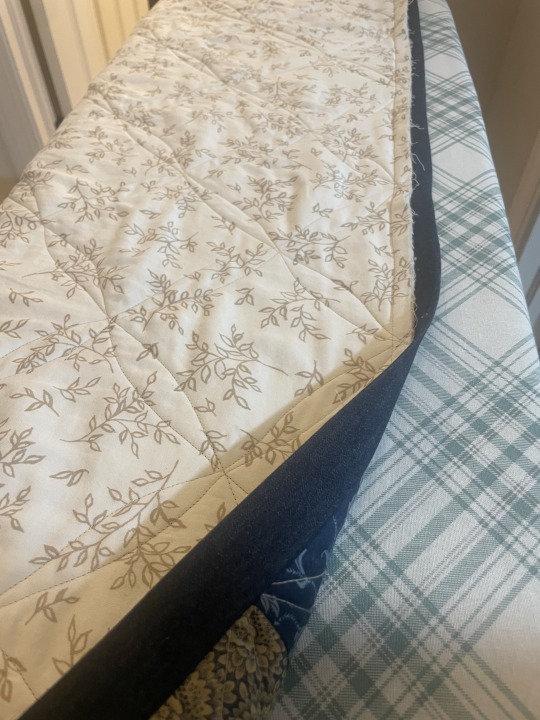


All finished with my quilt! I used HeirloomCreations method for binding (https://www.youtube.com/watch?v=xWh90tXr7g4) and did stitch in the ditch for finishing it up and it worked so well!
So excited to be done and I'm already looking forward to my next project. I have fabric ready for another quilt and I'm about halfway finished with another. I also am interesting in making a quilt with houses on it and trying out an embroidery like the Lace Cottage.
Today I went to Golden with my family for my aunts birthday and it was such a fantastics day. We got breakfast and walked around downtown Golden. We also went into a quilt shop. They had so many quilts for sale that they lost some of their excitement. Such a great day though.
One more week of work and then I have the week off for Christmas. I'm really looking forward to some chill time and I hope to get some good crafting time in as well as some pickleball and some of the to-do's I've been putting off.
#quilt#quilting#quilters of tumblr#quilt pattern#textile arts#quiltblr#patchwork#quilt block#journal#journal enteries#crafting#craft journal
14 notes
·
View notes
Text
BAHAMA - AESPA kitschy summer scrapbook page 🌴🐬🫧🌈✨️🌊🪸🐠🪼🐚🦩
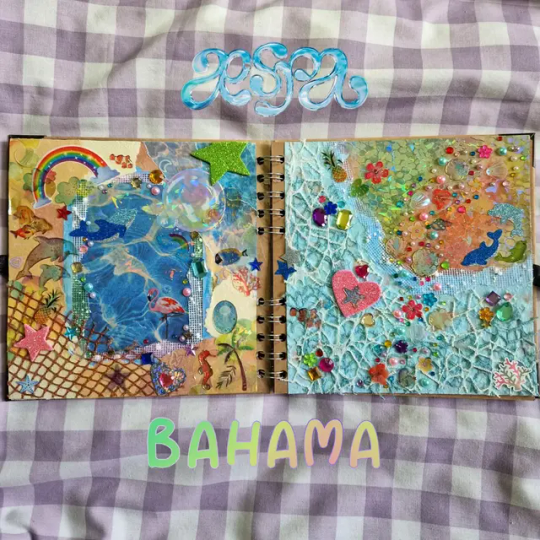

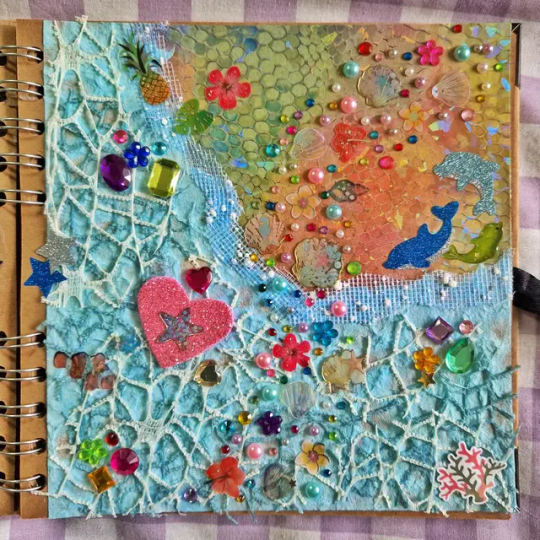







#art#art of tumblr#artists on tumblr#traditional art#aespa fanart#aespa#aespa giselle#aespa ningning#aespa karina#aespa winter#scrapbook#scrapbooking#scrapbook pages#journalling#moodboard#kitsch#textiles#tropical#oceancore#kpop fanart#kpop#collage#mixed media#Spotify
28 notes
·
View notes
Text


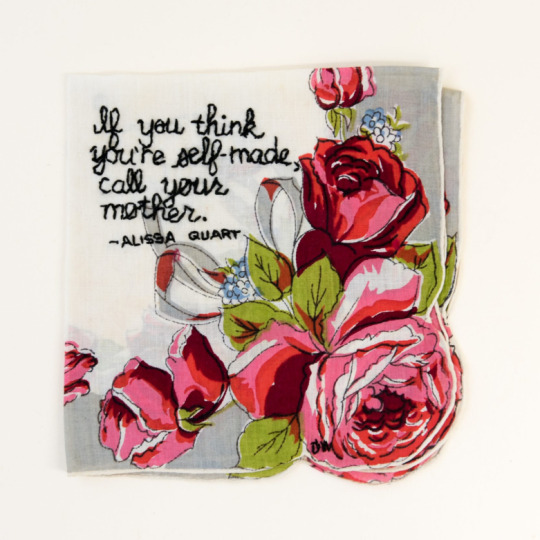
Stitch artist Diana Weymar collaborated with the Economic Hardship Reporting Project to center the work of writers tackling economic and racial justice — using embroidery.
#diana weymar#economic hardship reporting project#textile art#embroidery#art#artists#journalism#design#activism#artivism
79 notes
·
View notes
Text
I made a random necklace. I have been trying to figure out what to do with this big ass charm. I personally love a chunky necklace.

Beadsssssssssssssss

#jewelry#chunky jewelry#southwestern#diy projects#diy#diy craft#random things#things i made#i made this#crafty things#crafts#craftblr#hand crafted#artists on tumblr#textile art#my art#art#artwork#my artwork#journal entry#journal#my journal#my jewelry#my diary#online blog#online diary#photographers on tumblr#spotify#aaliyah#90s
3 notes
·
View notes
Text

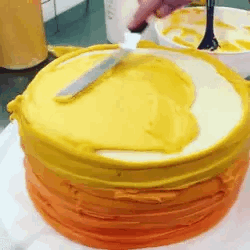
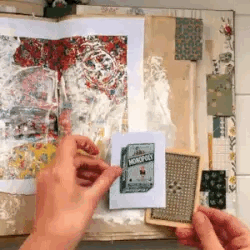

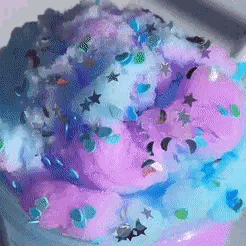

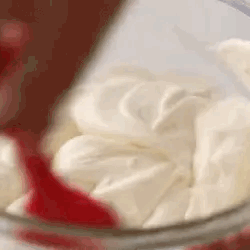
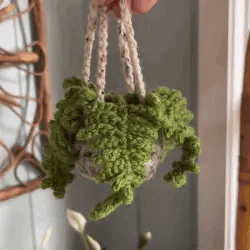
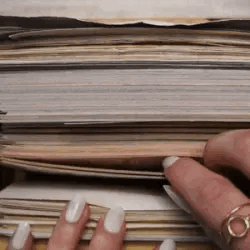
I’LL NEVER GO BACK TO GEORGIA, NOT AT LEAST TIL I HAVE TO
🎂 🎂 🎂
🔍 🔍 🔍
☀️ ☀️ ☀️
#you dont ask questions about project mayhem [boards]#deliver me from being perfect and complete [queue]#lyrics: jamie all over by mayday parade#baking#food#mixing#batter#cake#frosting#cake decorating#dessert#scrapbooking#books#paper#journaling#academia#slime#crochet#plants#textiles#white#yellow#orange#brown#tan#beige#purple#blue#green#stim
6 notes
·
View notes
Text
I knew someone who would have loved to thrift these.


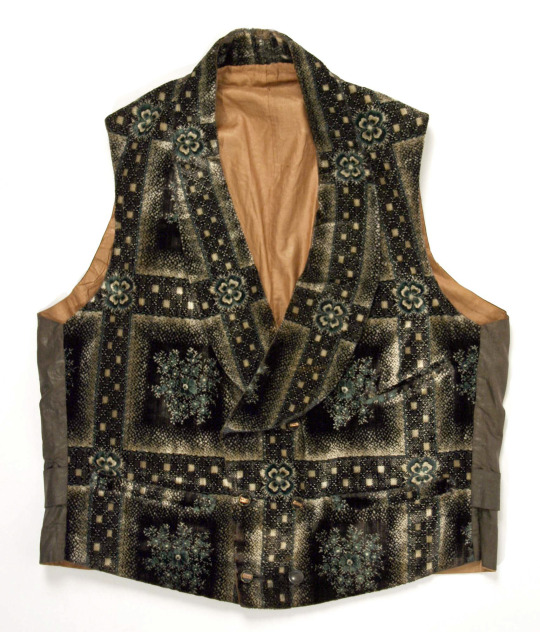
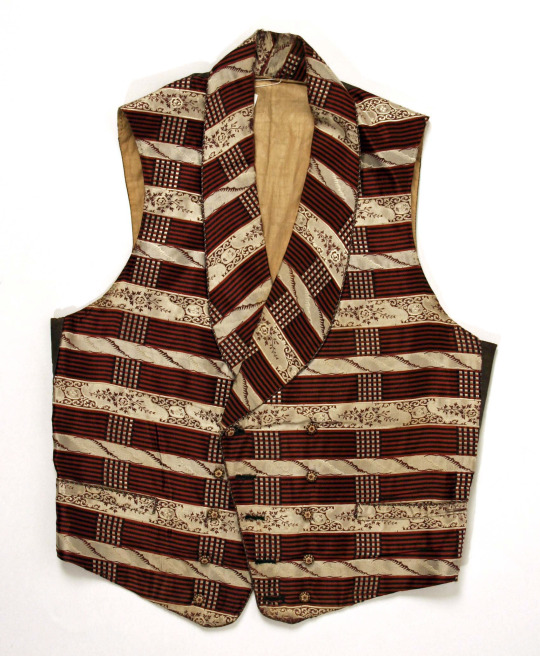


waistcoats, c. 1840s-50s.
3K notes
·
View notes
Text
Texturas en los Bocetos de Alta Costura para Caballero


La ilustración de moda es una herramienta clave en el diseño, utilizada para plasmar ideas, explorar estilos y comunicar conceptos a fabricantes y clientes. Su origen se remonta al Renacimiento, pero ganó relevancia en los siglos XVIII y XIX con revistas especializadas. Aunque la fotografía redujo su presencia en medios, sigue siendo esencial en el proceso creativo, combinando técnicas tradicionales y digitales.
Se usa para conceptualizar diseños, presentar colecciones, crear fichas técnicas y en marketing. Aporta creatividad y precisión, facilitando la transformación de ideas en prendas reales.
Importancia de las Texturas
La textura es uno de los elementos más poderosos del diseño de moda, ya que puede crear interés visual y táctil, contraste y armonía en cualquier atuendo. La textura se refiere a la calidad de la superficie de una tela o material, como lisa, áspera, difusa, brillante o mate.


También puede referirse a la forma en que se manipula una tela, como plisada, drapeada, fruncida o acolchada. A continuación veremos algunas de las formas más efectivas de usar la textura en el diseño de moda y cómo equilibrarla con otros elementos como el color, la forma y el patrón.
Cómo Utilizarlas

Elige texturas que se adaptasen a tu estilo y mensaje
El primer paso para usar la textura de manera efectiva es elegir texturas que coincidan con tu estilo personal y el mensaje que deseas transmitir con tu atuendo.
Experimenta con combinaciones de texturas
Una de las formas más divertidas y creativas de usar la textura en el diseño de moda es experimentar con diferentes combinaciones de texturas y ver cómo afectan el estado de ánimo general y la impresión de tu atuendo.
Equilibra la textura con otros elementos
Si bien la textura puede agregar mucho interés y personalidad a tu atuendo, también puede abrumar o chocar con otros elementos, como el color, la forma y el patrón. Para equilibrar la textura con otros elementos, hay que tener en cuenta el peso visual, la escala y la armonía de cada componente.

Usa la textura para realizar tu silueta y la forma de tu cuerpo
Otra forma de usar la textura de manera efectiva en el diseño de moda es usarla para mejorar la silueta y la forma del cuerpo, y crear atuendos favorecedores y cómodos. La textura puede afectar el aspecto de tu cuerpo al añadir volumen, dimensión o definición a ciertas zonas.
Siga a las tendencias y revisiones de textura
La última forma de usar la textura de manera efectiva en el diseño de moda es seguir las tendencias y pronósticos de textura, y ver cómo reflejan el estado de ánimo y la cultura actuales del mundo de la moda.
Texturas más utilizadas
La alta costura para caballeros se distingue por la atención al detalle y la selección de texturas que realzan la prenda. Algunas de las texturas más utilizadas son:

Telas naturales:
Lana: Su calidez y elegancia la hacen ideal para trajes y abrigos.
Algodón: Su versatilidad permite su uso en camisas y prendas más casuales.
Lino: Su frescura y ligereza son perfectas para climas cálidos.
Seda: Su suavidad y brillo aportan un toque de lujo a camisas y corbatas.

Telas sintética:
Poliéster: Su resistencia y durabilidad lo hacen ideal para prendas de
uso diario.
Nylon: Su ligereza y resistencia al agua lo hacen perfecto para prendas
deportivas.

Telas tejidas:
Espiga: Su patrón en forma de V crea un efecto visual interesante.
Gabardina: Es un tipo de tela tejida que puede estar compuesta por algodón,
poliéster lana poliéster viscosa o fibra sintética.
Casimir: Este es un tejido que permite lograr diferentes gramajes.
Sarga: Su tejido diagonal le da a la prenda un aspecto robusto.

Texturas estampadas:
Cuadros: Su versatilidad permite su uso en camisas, trajes y accesorios.
Rayas: Su elegancia atemporal las hace perfectas para trajes y camisas.
Estampados abstractos: Su originalidad añade un toque moderno a la prenda.
Referencias:
Bruto. (2019, February 3). historia de la ilustracion de moda. Estudios En Dibujo. https://dibujourjc.wordpress.com/2019/02/03/historia-de-la-ilustracion-de-moda/?utm_source=chatgpt.com
¿Cuáles son las formas más efectivas de usar la textura en el diseño de moda? (2024, 1 enero). www.linkedin.com. https://es.linkedin.com/advice/3/what-most-
effective-ways-use-texture-fashion-m57rc?lang=es&lang=es#:~:text=La%20textura%20es%20uno%20de,%2C%20difusa%2C%20brillante%20o%20mate.
Morales, J. P. (2018, March 21). La clave de un buen Traje esta en la tela. Havoc. https://havoc.mx/blogs/havoc/la-clave-de-un-buen-traje-esta-en-la-tela
Admin.Blog. (2021, August 11). ¿Qué tipos de telas se usan para la sastrería? | Hitega. Blog. https://www.hitega.cl/blog/tipos-de-telas/que-tipos-de-telas-se-usan-
para-la-sastreria/
Admin.Blog. (2021a, August 9). Uniformes para empresas: 3 ideas de telas para confeccionarlos | Hitega. Blog. https://www.hitega.cl/blog/tips-de-telas/uniformes-
para-empresas-3-ideas-de-telas-para-confeccionarlos/
Ramos, M. F. R. (2025, January 21). Tipos de telas y tejidos. Euroinnova International Online Education. https://www.euroinnova.com/profesiones-y-
oficios/articulos/tipos-de-telas-y-tejidos
Equipo editorial, Etecé. (2024, October 23). Lana: origen, propiedades, usos y características. Enciclopedia Humanidades.
https://humanidades.com/lana/#:~:text=Comercio%20de%20lana&text=La%20industria%20textil%20de%20la,Campo%20y%20Bilbao%20en%20Espa%C3%B1a.
marjorie pin. (2021, December 9). Como ilustrar textura de lana en un figurín de moda [Video]. YouTube. https://www.youtube.com/watch?v=isbpdBiGAUU
Athm_B74bf. (n.d.). Tejido de seda: Historia, propiedades, cómo se fabrica. https://www.athm.org/es/tejido-de-seda-historia-propiedades-como-se-fabrica/
Wanda Rosario. (2025, January 19). DIBUJA TEXTURAS DE TELAS|Lana, Cuero, Seda y Terciopelo. [Video]. YouTube. https://www.youtube.com/watch?
v=fhTUXOc458w
#fashion#arte textil#fashion design#clothing#alternative#style#fashion history#information#textildesign#fashion student#blog#aesthetic#tumblr#haute couture#fashion clothing#textiles#mexico#social media#moda#male model#street style#alt fashion#journal
1 note
·
View note
Text
"The substances behind the slimy strings from okra and the gel from fenugreek seeds could trap microplastics better than a commonly used synthetic polymer.
Texas researchers proposed in 2022 using these sticky natural polymers to clean up water. Now, they’ve found that okra and/or fenugreek extracts attracted and removed up to 90% of microplastics from ocean water, freshwater, and groundwater.
With funding from the U.S. Department of Energy, Rajani Srinivasan and colleagues at Tarleton State University found that the plant-based polymers from okra, fenugreek, and tamarind stick to microplastics, clumping together and sinking for easy separation from water.
In this next stage of the research, they have optimized the process for okra and fenugreek extracts and tested results in a variety of types of water.
To extract the sticky plant polymers, the team soaked sliced okra pods and blended fenugreek seeds in separate containers of water overnight. Then, researchers removed the dissolved extracts from each solution and dried them into powders.
Analyses published in the American Chemical Society journal showed that the powdered extracts contained polysaccharides, which are natural polymers. Initial tests in pure water spiked with microplastics showed that:
One gram of either powder in a quart (one liter) of water trapped microplastics the most effectively.
Dried okra and fenugreek extracts removed 67% and 93%, respectively, of the plastic in an hour.
A mixture of equal parts okra and fenugreek powder reached maximum removal efficiency (70%) within 30 minutes.
The natural polymers performed significantly better than the synthetic, commercially available polyacrylamide polymer used in wastewater treatment.
Then the researchers tested the plant extracts on real microplastic-polluted water. They collected samples from waterbodies around Texas and brought them to the lab. The plant extract removal efficiency changed depending on the original water source.
Okra worked best in ocean water (80%), fenugreek in groundwater (80-90%), and the 1:1 combination of okra and fenugreek in freshwater (77%).
The researchers hypothesize that the natural polymers had different efficiencies because each water sample had different types, sizes and shapes of microplastics.
Polyacrylamide, which is currently used to remove contaminants during wastewater treatment, has low toxicity, but its precursor acrylamide is considered toxic. Okra and fenugreek extracts could serve as biodegradable and nontoxic alternatives.
���Utilizing these plant-based extracts in water treatment will remove microplastics and other pollutants without introducing additional toxic substances to the treated water,” said Srinivasan in a media release, “thus reducing long-term health risks to the population.”
She had previously studied the use of food-grade plant extracts as non-toxic flocculants to remove textile-based pollutants from wastewater and thought, ‘Why not try microplastics?’"
-via Good News Network, May 10, 2025
#watere#water pollution#microplastics#plastic#plastic pollution#pollution#solarpunk#environment#okra#fenugreek#united states#north america#texas#environmental science#good news#hope
16K notes
·
View notes
Text
Exploring Scottish Textiles: A Wool Lover's Dream
Day 1: Edinburgh Knitting Tour of the Scottish Highlands By DEBORA RAGLAND BUERK,Writer, editor, andsometimes family historian. The Write Stuff. Scottish Textiles Showcase. After touring the Edinburgh Castle, we were welcomed at the Scottish Textiles Showcase, a unique shop in Edinburgh that focuses on Scottish wool products. Shop owner Kitty Mackenzie greeted us with mimosas and a chance to…
#edinburgh#Knitting Tours.com#Scotland#Susan Anderson#The Journal of Scottish Yarn#The Scottish Textiles Showcase
0 notes
Text
Child's Sock from Egypt, c.250-350 CE: this colorful sock is nearly 1,700 years old

This tiny sock was discovered during excavations in the ancient city of Oxyrhynchus, in Egypt, and it was likely created for a child during the late Roman period, c.250-350 CE.
Similar-looking socks from late antiquity and the early Byzantine period have also been found at several other sites throughout Egypt; these socks often have colorful, striped patterns with divided toes, and they were crafted out of wool using a technique known as nålbinding.

Above: a similar child's sock from Antinoöpolis, in Egypt, c.250-350 CE
The sock depicted above was created during the same period, and it was found in a midden heap (an ancient rubbish pit) in the city of Antinoöpolis. A multispectral imaging analysis of this sock yielded some interesting results back in 2018, as this article explains:
... analysis revealed that the sock contained seven hues of wool yarn woven together in a meticulous, stripy pattern. Just three natural, plant-based dyes—madder roots for red, woad leaves for blue and weld flowers for yellow—were used to create the different color combinations featured on the sock, according to Joanne Dyer, lead author of the study.
In the paper, she and her co-authors explain that the imaging technique also revealed how the colors were mixed to create hues of green, purple and orange: In some cases, fibers of different colors were spun together; in others, individual yarns went through multiple dye baths.
Such intricacy is pretty impressive, considering that the ancient sock is both “tiny” and “fragile."
Given its size and orientation, the researchers believe it may have been worn on a child’s left foot.

Above: another child's sock from Al Fayyum, Egypt, c.300-500 CE
The ancient Egyptians employed a single-needle looping technique, often referred to as nålbindning, to create their socks. Notably, the approach could be used to separate the big toe and four other toes in the sock—which just may have given life to the ever-controversial socks-and-sandals trend.
Sources & More Info:
Manchester Museum: Child's Sock from Oxyrhynchus
British Museum: Sock from Antinoupolis
Royal Ontario Museum: Sock from Al Fayyum
Smithsonian Magazine: 1,700-Year-Old Sock Spins Yarn About Ancient Egyptian Fashion
The Guardian: Imaging Tool Unravels Secrets of Child's Sock from Ancient Egypt
PLOS ONE Journal: A Multispectral Imaging Approach Integrated into the Study of Late Antique Textiles from Egypt
National Museums Scotland: The Lost Sock
#archaeology#artifact#history#anthropology#child's sock#ancient textiles#ancient egypt#roman egypt#fabric arts#knitting#fashion#naalebinding#art#classical antiquity#children in archaeology#natural dyes#wool#yarn#ancient clothing#children#roman#sewing#egyptology#cute little stripy socks
6K notes
·
View notes
Text
Flexible Conductive Films Fabricated Using Exfoliated Graphite and Nanocellulose- Crimson Publishers
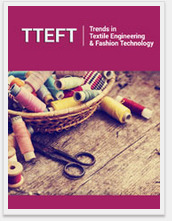
Flexible Conductive Films Fabricated Using Exfoliated Graphite and Nanocellulose- Crimson Publishers
Development of nanostructured composite materials based on exfoliated graphite and nanocellulose for applications in flexible electronics including smart textiles is described. High electrical conductivities, near 140kS/m, comparable with conventional conductive materials like metals, as well as good mechanical properties, were measured for the graphite-cellulose compound.
For more open access journals in crimson publishers Please click on link: https://crimsonpublishers.com
For more articles on Trends in Textile Engineering & Fashion Technology Please click on link: https://crimsonpublishers.com/tteft/
#fashion design#textile engineering#textile#fashion technology#crimson-textile#crimson publishers journals
0 notes
Text
der Arbeitstage und der Alltagsleben
Hallo!
Silje, her! 😊
Ich hoffe, alle hatten eine tolle Zeit 🙌 Dies ist ein Rückblick aud meinen Alltag und arbeidstag. Mit anderen Worten, das Leben eins archäologenstudenten im materstudiengang in Norwegen.
Mein Tag beginnt bereits um 05:00 Uhr morgens. Wenn ich so früh aufstehe, habe ich Zeit, Dinge für mich selbst zu tun. Sich auf den tag vorzubereiten ist auch eine möglichkeit, auf sich selbst aufzupassen. Das Wichtigste, was ich morgens mache, ist Kaffee kochen. Dann Früuhstrück und Wiederholung des Deutsch- oder Bilogienunterrichts online (youtube).
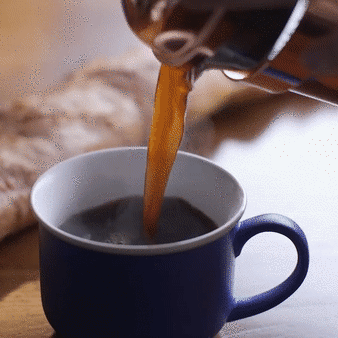
Nach all dem die Schultasche packen und dann zur der Universität. Wenn Sie Früher abreisen als nötig, vermeiden Sie volle Buss und längere Werteyeiten auf dem Weg zur Universität. Da ich früher an der Uni ankommen, habe ich Zeit, mich mit einer Tasse Kaffee hinzusetzen, bevor ich voll in den Arbeidstag starte. In der Regel erledige ich gleichzeitig, was ich tagsüber erledigen muss.
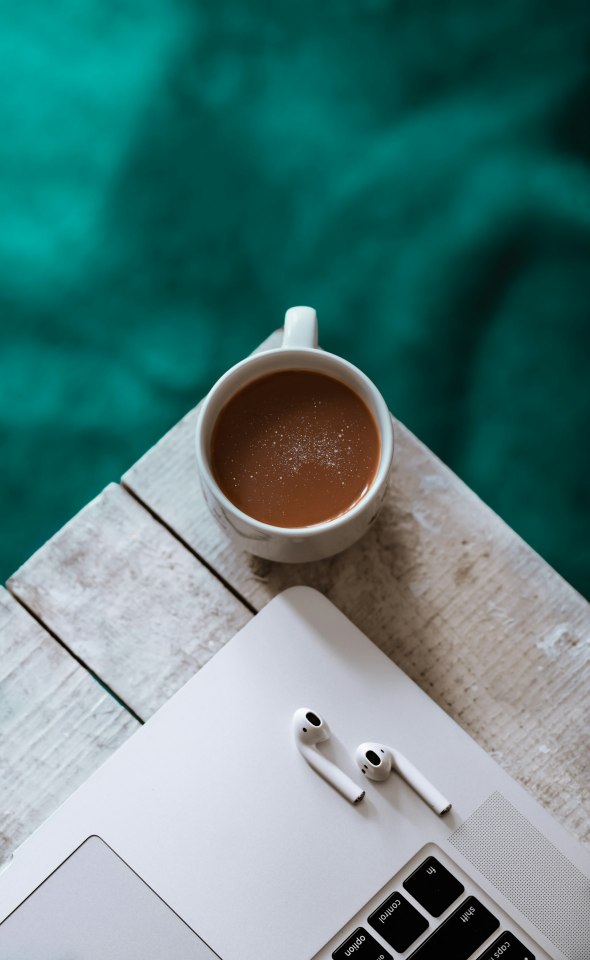
Mein Alltagsleben ist in letzter Zeit sehr beschäftigt 😅 Der Alltag besteht darin, von 08:00 Uhr morgens bis 16:00 Uhr nachmittags in den Lesesaal zu gehen und dort zu sitzen. Etwas später am Vormittag kommen mehr Studerende in den Lesesaal, sodass bei Bedarf auch gemeinsam gearbeitet werden kann. Er ist wichtig zu erwähnen, dass alle in meinem Lesesall Archäologiestudenten das Masterstudiengangs sind. Am Wochenende habe ich beispielsweisen sowohl Kapitelentmürfe als auch Vorlesungen für kommilitonen durchgesehen.
Meine Masterarbeit befasst sich mit Textilien aus dem Mittelalter und dem Import und Export in Norwegen in einer bestimmten mittelalterlichen Stadt. Tatsächlich ist es eine bestimmte Art von Textil, nach der ich suche. Meine Hypothese ist, dass diese Art von Textilien in frühen Phasen des Mittelalters importiert und nicht in Norwegen Hergestillt.
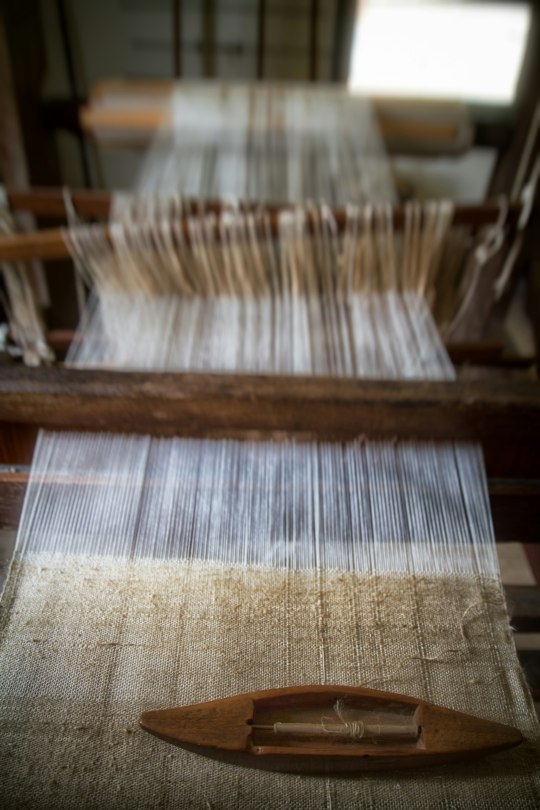
Wie bei allen Jobs kann es auf dem Weg zu Problemen kommen, mit denen man sich befassen muss. Textilien sind etwas, mit dem jader eine Beziehung hat. Deshalb ist ein Privileg, Textilien aus älteren Zeiten der Menschheitegeschichte erforschen zu dürfen.
Manchmal gibt es viel zu tun sowohl mit der Arbeit am Master als auch mit der Arbeit am Deutsch. Deshalb habe ich mich entschieden, diesen Blog zu starten. Da meine Muttersprache Norwegisch ist, fallen beim Lesen einige Parallelen zur deutschen Sprache auf.
Einer der Gründe, warum ich versuche, Deutsch zu lernen, ist dass ich mich weiterhin mit Textilien befassen möchte (mein Artikel ist auf Deutsch über ältere Textilen geschrieben).
Das war eine gute Übung. Probieren Sie es auch gerne aus und verlinken Sie mivh auf den Beitrag, dann schaue ich es mir an.
Bis zum nächsten Mal viel Spaß!

#archeology#textiles#textilien#learning german#german#language journal#language blog#language study#language learning#language#blog#mittelalter#master thesis#hypothese#archäologie#my post#my writing#learning#learnsomethingneweveryday#education#dyslexie#dyslexia#dyslexic#writing#writing advice#loom weaving#old textiles#weaving#fibers#medival
1 note
·
View note
Link
2023-14-18December by SilviaGalasso
#christmas#vintage inspired#writing#collage journal#styling#dolls#textile art#pinocchio#collodi#xmas decor#home decor#silvia galasso stylist#marchesamora#diary
0 notes
Text
[Paper] The origins of southeast Asian weaving traditions: the perspective from archaeology
via Asian Archaeology, 18 September 2023: New data reveals the Neolithic roots of Southeast Asian weaving, with Southwestern China as a key innovation hub.
via Asian Archaeology, 18 September 2023: Paper by Buckley delves into the origins and spread of spindle whorls across southern China and Southeast Asia. The study reveals that the presence of spindle whorls in mainland Southeast Asia is closely tied to Neolithic agricultural practices, particularly rice farming. Southwestern China is identified as a pivotal center for weaving innovation,…

View On WordPress
#agriculture#Asian Archaeology (journal)#China#Neolithic#research papers#rice#spindle whorls#weaving and textiles
0 notes